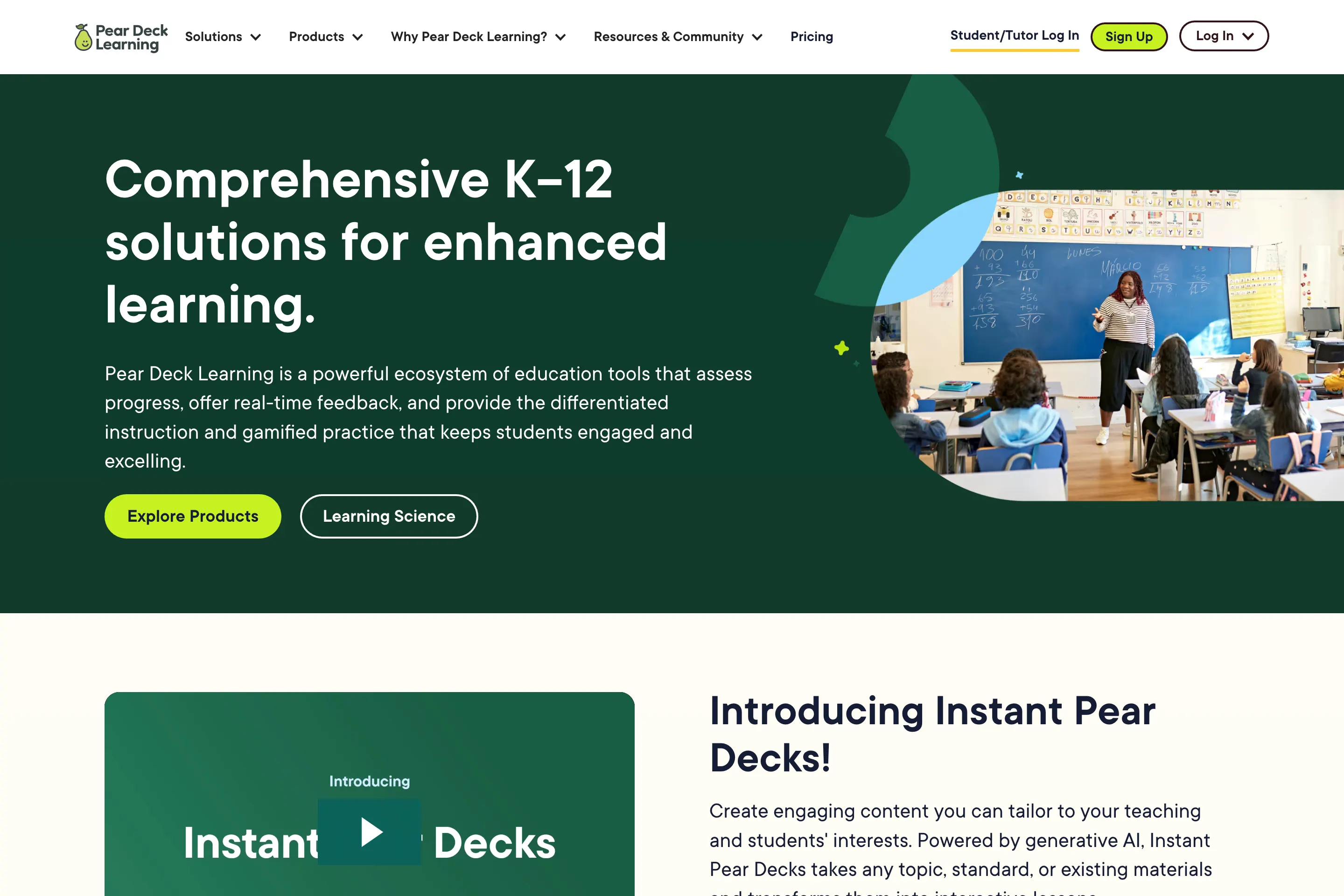Best Tech to Help New Teachers with Classroom Management

By Katie Schuknecht
Updated on Jan 28, 2025

With thousands of learning apps available for the classroom, it can be challenging to determine which resources best suit students' needs. Here, we cover some of the most popular digital learning tools to help you prepare for your new classroom.
Why Apps are Important in the Classroom
During the 2023-2024 school year, the average educator used 49 different edtech products in the classroom. Teachers use educational technology to assess students, analyze student data, access supplemental materials, provide whole-group instruction, differentiate lessons, and more.
Here are three reasons apps are needed in the classroom:
1. Apps help enhance the learning experience.
The right tools help streamline tedious classroom tasks. You can use apps to offer immediate assessment feedback, differentiate instruction to meet each learner's level, and gather data to guide classroom decisions.
2. Edtech makes collaborating easy.
Technology makes collaborating with other people involved in students' education (like family members and other teachers) easier. Apps simplify communication with family members so they can stay informed about their child's behavior and performance.
Tech tools are also critical when collaborating with other teachers. Team teachers often share a behavior management platform for their shared learners. Some schools use apps like Google Classroom to store all school-related information in a single platform.
3. Tech tools improve behavior management.
Behavior management efforts increase student engagement when you turn them into a game! Thanks to some classroom technology, you can do just that, engaging even the most reluctant students. Most apps will store data for the school year. This feature is handy when you need to evaluate and discuss patterns of student behavior with parents or administrators.

Considerations for Choosing Apps for Classroom Management
Several factors must be considered when creating your classroom tech stack. Knowing your non-negotiables narrows your search and simplifies the process of weeding through the almost 10,000 edtech products currently on the market.
Relevance: Grade Level and Age of Students
Tech tools are typically age-specific, which makes sense. A kindergarten teacher wouldn't use the same apps as a 6th-grade teacher. Consider which features and capabilities will appeal to your students based on grade level and age.
Navigation: Ease of Use for Teachers and Students
Many apps are designed to simplify the learning curve for new users, but some tools take longer to learn and implement in the classroom. New teachers may start the year using tools they and their students are comfortable with and then add new apps throughout the semester.
Kids are quick learners, especially with technology, and they often easily adapt to new apps. Don’t be afraid to try something new at least once. If it’s too challenging to navigate, you can scrap the tool and return to a more familiar option. You can also evaluate an app's navigation capabilities in a small group lesson before using it with the entire class.
Customization: Ability to Alter Content and Settings to Meet Classroom Needs
Save time in the future by choosing apps that can be used for different subjects, learning levels, and learning objectives. For example, a tech stack of 10 customizable apps is easier to manage than a list of 30 super-specific tools you use for various classes.
Some tools allow you to access a library of free content and tweak it to meet your specific needs. This customization helps save precious time and learn from veteran teachers who have already covered the same topics.
Accessibility: Mobile Device Use, Personalization, Flexible Settings
Ensure that apps used in the classroom are accessible to all students so everyone can access the same instruction. Skip tools without a desktop and mobile format. For example, make sure they have a website and app. Choose apps with accessibility features or those that integrate with programs that make them more accessible.
Best Apps for Classroom Management
Below are some popular apps you might use to facilitate learning, manage classroom behavior, and communicate with caregivers. Many can be used alongside one another, helping create the optimal classroom experience for you and your students.

Google Classroom
Google Classroom is a learning management system that integrates with all Google Workspace tools, such as Google Docs, Google Slides (either generated in the app or uploaded and converted PowerPoint slides), and Google Drive.
Once students are added to Google Classroom, teachers can use it to communicate with them and assign work.
Google Classroom is frequently used in school districts that subscribe to Google Workspace. It is a central location for students to access their classes.
The integration with other Google Workspace tools allows for easy navigation between products. For example, teachers can assign work in a Google Doc, which students complete and upload to the classroom for grading.

Apple Classroom
Apple Classroom is an app designed primarily for Apple devices. It helps teachers monitor and facilitate student learning on iPads and Macs and can act as a whiteboard.
The best uses for this app are keeping students on task by locking them into specific apps or seeing what students are doing when they seem distracted.
With Apple Classroom, teachers can simultaneously control any number of student Apple devices, making it useful for differentiating instruction. For example, teachers can share leveled texts with different groups of students for guided reading or open a specific app that a group should be working on.
Google Classroom and Apple Classroom are excellent for remote learning.

Classdojo
Classdojo is a real-time communication tool that connects parents and teachers. Features such as teacher quiet hours and instant translations encourage respectful and open communication. A classwide private feed gives a glimpse into the classroom with photos and videos.
''The platform is also used to manage student behavior with points. Students earn a dojo or lose points with a ‘nojo.’ Parents can access their child's account and receive live updates throughout the school day.

Seesaw
Designed specifically for elementary classrooms, Seesaw is typically used to share student work with families using digital portfolios. It also offers a two-way communication channel where teachers can share class-wide announcements and have one-on-one conversations with parents.
Messages can be translated into more than 100 languages, removing potential language barriers so teachers can connect with all families.

Classkick
Using Classkick, teachers can assign work to their students by uploading something they already created, creating something new within the platform, or using templates already available on the app.
Students can interact with assignments in various ways. For example, they might individually count the number of objects in a picture, record their answer on a screen, or work in groups to complete a STEM challenge. This app provides immediate feedback and support as needed.

Dropbox
Dropbox is an online storage and file-sharing tool. Teachers can use it as a virtual library to organize all their digital resources.
Once documents are uploaded into a teacher's Dropbox, they can be shared with students as assignments. When students upload their work to Dropbox, teachers can annotate the document to provide feedback.

Remind
Use Remind to stay in touch with parents. Teachers can directly add parents to a class they create or share a code that parents can use to join.
One standout feature of Remind is that parents can receive updates on the app, via text, or both. This feature makes it easier to stay in touch with people who do not:
have space to or interest in downloading another app
check email often
want to keep up with a class social media account

Thinglink
Thinglink is an app that allows teachers to add notes, links, and questions to media such as pictures and videos. Doing so helps create a more engaging learning experience for students. Thinglink is also used to create 360-degree media, perfect for virtual field trips or immersive learning environments. It is like virtual reality without the headset!

Pear Deck Learning
Three Pear Deck Learning products enhance classroom learning. Gamified instruction and assessment keep students engaged and excited to learn.
Pear Assessment offers standards-based assessment tools.
Pear Deck allows teachers to create interactive presentations.
Pear Practice provides differentiated learning practice for students.

Quizizz
Used to create interactive quizzes and games, Quizizz boasts a content library of more than 30 million customizable activities, great for various student learning styles. Teachers can use the tool for:
live, class-wide quiz sessions
assigning homework
individual or team game-based learning

Kahoot!
This game-based platform allows teachers to create learning games and quizzes to introduce or review content, providing a hands-on learning experience. Kahoot games can be played class-wide or individually at the student's own pace, depending on your goals for the specific lesson.
Kahoot is another app that allows for lesson planning, as well.
Conclusion
The right digital platform and apps can make a significant difference when teaching students. Follow the tips here, research, and contact your grade-level team to ensure the best use of technology for your new classroom. The learning tools you use can make all the difference!